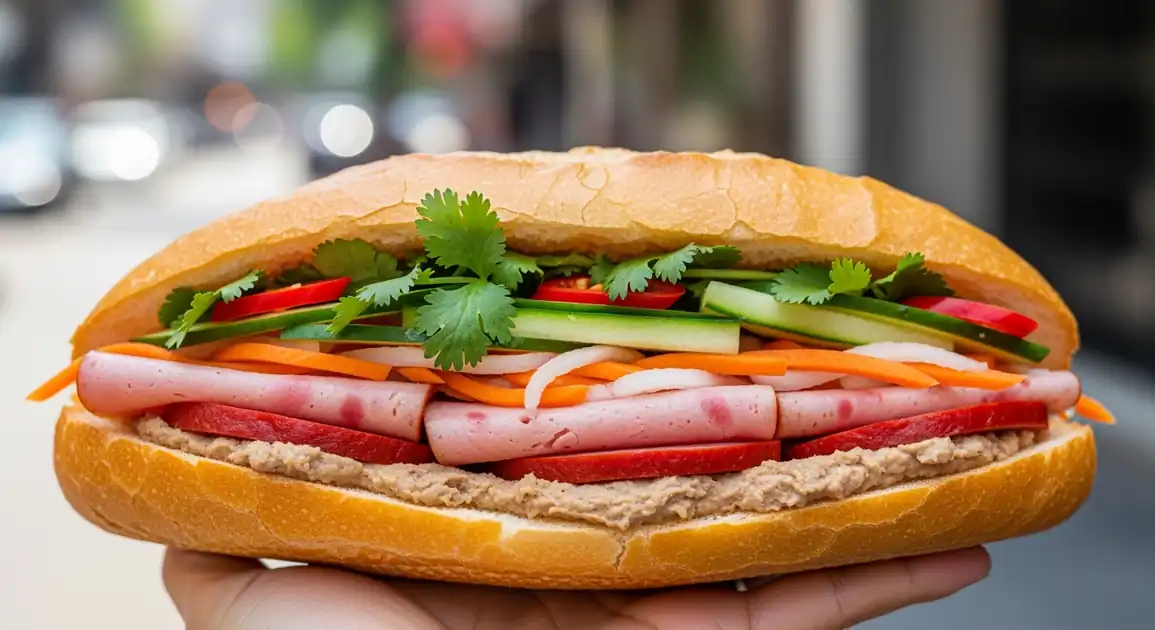Bánh mì (Vietnamese Baguette Sandwich)
Bánh mì

Description
Hanoi's Bánh mì scene often emphasizes tradition and subtlety. While diverse options exist, the classic Hanoi style often features high-quality pâté, select cold cuts, and perhaps butter, with less sauce and fewer herbs than its Southern counterpart. The focus is often on the quality of the core ingredients.
Dietary Information
Serving information
Serving style
Typically served whole, wrapped in simple paper. Often contains fewer ingredients but focuses on quality. Chili is usually offered separately or added sparingly.
Quick facts
Primarily morning (6 AM - 10 AM) and afternoon/evening (3 PM - 9 PM). Fewer late-night options compared to HCMC.
Safety Tips
What to Look For
-
Fresh, crispy baguette
Bread should be light with a crisp crust, not stale or chewy. Often kept warm or toasted quickly before assembly.
-
Clean preparation area and utensils
Look for clean cutting boards (separate for meat/veg ideally), knives, and vendor hands/gloves. Avoid vendors with visibly dirty setups.
-
Fresh-looking pickles (đồ chua) and herbs (cilantro)
Pickles should be brightly colored and crisp, herbs should be vibrant green and unwilted. Indicates fresh ingredients.
-
High customer turnover
Busy stalls mean ingredients are used quickly and replenished often, reducing the time fillings sit out.
-
Proper handling of ingredients
Vendor uses tongs, gloves, or clean hands, avoids cross-contaminating ingredients (e.g., touching money then food).
-
Pâté and mayo look fresh
Observe the texture and color; avoid if they look discolored, dried out, or stored improperly in heat.
What to avoid
-
Stale or soft bread
Significantly detracts from the Bánh mì experience and may indicate the vendor isn't focused on quality.
-
Wilted herbs or dull-looking pickles
Suggests ingredients are not fresh, impacting flavor and potentially safety.
-
Fillings left uncovered and exposed for long periods
Increases risk of contamination from dust, insects, and bacterial growth, especially for pâté and meats.
-
Visible signs of poor hygiene
Dirty cart, cloths, utensils, or vendor practices (e.g., no handwashing) are red flags.
-
Re-using oil for fried elements (like ốp la)
If getting a Bánh mì with fried elements (like egg), ensure the oil looks reasonably clean.
Price information
Price range
Budget tips
- Simple street stalls offer great value (15,000-25,000 VND).
- Bánh mì pate or ốp la are usually the cheapest.
- Prices in the Old Quarter might be slightly inflated for tourists.
- Look for stalls frequented by locals just outside the main tourist drags.
Value indicators
- Excellent quality pâté (often a defining feature).
- Perfectly crispy baguette.
- Balanced, savory flavor profile, less sweetness.
- Freshness of the limited ingredients used.
Where to Find This Dish
Old Quarter (Hoàn Kiếm District)
Numerous stalls and shops, including famous spots like Bánh Mì 25 and street vendors on Hàng Bạc, Lương Ngọc Quyến.
Hoàn Kiếm Lake, St. Joseph's Cathedral, Ta Hiện Beer Street
Morning, Afternoon, Evening
Near Universities
Areas around universities often have good, affordable Bánh mì stalls.
Hanoi National University, Foreign Trade University
Morning, Lunch
Local Markets
Stalls within or near markets like Chợ Hôm or Chợ Đồng Xuân.
Chợ Hôm, Chợ Đồng Xuân
Morning
Vendor Tips
- If you want more herbs or pickles, you might need to specifically ask ('cho thêm rau').
- Don't expect the heavily loaded style common in the South.
- Try stalls specializing in 'pate' for a classic Hanoi experience.
- Famous spots like Banh Mi 25 cater well to tourists with clear menus.
How to Order
Regional Variations
-
Focus on Pâté
(Bánh mì pa tê)
Many Hanoi stalls pride themselves on their homemade pâté, which is often the star ingredient.
-
Simpler Fillings
(Ít nhân hơn)
Classic Hanoi Bánh mì might just have pâté, butter/margarine, a type of pork roll or ham, and minimal condiments.
-
Bánh mì Dân Tổ
(Bánh mì Dân Tổ)
A unique late-night/early-morning Hanoi specialty where fillings (pâté, egg, sausage, dried beef) are stir-fried together before being put in the baguette.
-
Less Sweetness
(Ít ngọt)
Overall flavor profile tends to be more savory and less reliant on sweet sauces or overly sweet pickles.
Cultural context
History
The baguette was introduced to Vietnam by the French during the colonial period. Initially, it was eaten simply with butter or pâté. After the French withdrawal in 1954, Vietnamese vendors adapted the sandwich, adding local ingredients like Vietnamese cold cuts (chả lụa), pickled vegetables, herbs, and sauces, transforming it into the Bánh mì we know today. It became an affordable and popular staple food, evolving with distinct regional variations across North, Central, and South Vietnam.
Local significance
A staple food integrated into the daily rhythm of Hanoi life. Often seen as a more traditional, less 'showy' version compared to other regions.
Eating customs
- Consumed quickly and efficiently.
- Often bought from a familiar neighborhood vendor.
- Less common to see extremely customized orders compared to the south.